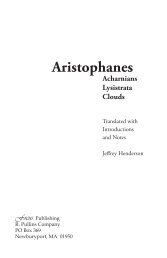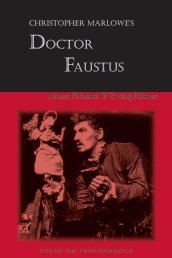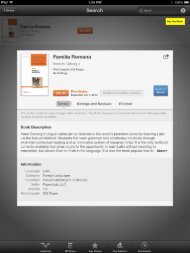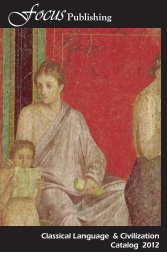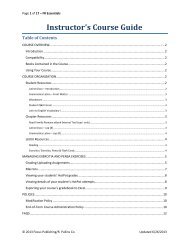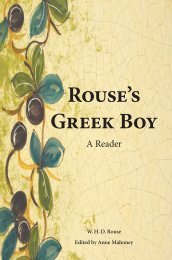The Process of Dramaturgy - Focus Publishing
The Process of Dramaturgy - Focus Publishing
The Process of Dramaturgy - Focus Publishing
Create successful ePaper yourself
Turn your PDF publications into a flip-book with our unique Google optimized e-Paper software.
<strong>The</strong> <strong>Process</strong> <strong>of</strong> <strong>Dramaturgy</strong>A HandbookScott R. IrelanAugustana College (IL)Anne FletcherSouthern Illinois University CarbondaleJulie Felise DubinerActors <strong>The</strong>atre <strong>of</strong> Louisville
Introduction xiiiJudith Rudak<strong>of</strong>f and Lynn Thomson, and What is <strong>Dramaturgy</strong>? editedby Bert Cardullo. While quite informative and useful in theirown right, the target audience for these particular compilations seemsto be established pr<strong>of</strong>essionals and seasoned academics. In contrast,our intention is to broaden the scope <strong>of</strong> inquiry to meet the needs <strong>of</strong>production dramaturgs whatever their education level or pr<strong>of</strong>essionalstanding. Additionally, What is <strong>Dramaturgy</strong> (though in its third reprinting)is fourteen years old, Between the Lines is over five years old,and <strong>Dramaturgy</strong> in the American <strong>The</strong>atre is more than ten years old.In the time since these editions were first released there has been aconsistent critical reappraisal <strong>of</strong> production dramaturgy and the role <strong>of</strong>the production dramaturg (and literary manager for that matter). Thistrend is best exemplified by <strong>Dramaturgy</strong> and Performance by CathyTurner and Synne Behrndt in which the authors review a variety <strong>of</strong>perspectives on the term “production dramaturgy”. Other recent examplesinclude <strong>Dramaturgy</strong>: A Revolution in <strong>The</strong>atre in which MaryLuckhurst covers the history <strong>of</strong> the origins <strong>of</strong> production dramaturgs,literary managers and play doctors, as well as Andrew Hartley’s <strong>The</strong>Shakespearean Dramaturg: A <strong>The</strong>oretical and Practical Guide. While <strong>of</strong>feringsome practical tips in handbook format much like <strong>The</strong> <strong>Process</strong><strong>of</strong> <strong>Dramaturgy</strong>, Hartley’s work, as the title indicates, is limited by itsperiod-specific content and scope. Additionally, Ge<strong>of</strong>frey S. Proehl’sToward a Dramaturgical Sensibility: Landscape and Journey wrestleswith similar issues, though the author’s highly reflective tone distinguishesit from the others. While there is little by way <strong>of</strong> explicit “howto” for the neophyte production dramaturg, Proehl’s work does furtherthe discussion about dramaturgy, the production dramaturg andthe necessity <strong>of</strong> each in theatre and live performance in a unique andworthwhile way. Because the field <strong>of</strong> production dramaturgy is so expansiveboth in practice and in definition, a broad range <strong>of</strong> texts arenecessary for coursework regarding production dramaturgy, its historyand the role(s) <strong>of</strong> the production dramaturg. We recommend any com-
xiv<strong>The</strong> <strong>Process</strong> <strong>of</strong> <strong>Dramaturgy</strong>: A Handbookbination <strong>of</strong> the abovementioned texts as supplements to <strong>The</strong> <strong>Process</strong> <strong>of</strong><strong>Dramaturgy</strong>. 1<strong>The</strong> <strong>Process</strong> <strong>of</strong> <strong>Dramaturgy</strong> fills a gap, then, by specifically callingparticular attention to the myriad ways in which an individual mightgo about developing a production dramaturg’s aesthetic sensibilityon the road to committing “acts <strong>of</strong> dramaturgy” in the productionprocess. Given the seeming dearth <strong>of</strong> practical guides to productiondramaturgy and taking into account the precipitous rise in the number<strong>of</strong> course <strong>of</strong>ferings at both colleges and universities, our discussionexplores ways <strong>of</strong> initiating conversations about “named” or “unnamed”dramaturgical acts, which are an integral part <strong>of</strong> a production and worthy<strong>of</strong> further exploration. What makes <strong>The</strong> <strong>Process</strong> <strong>of</strong> <strong>Dramaturgy</strong> trulyunique is the way in which it suggests a place <strong>of</strong> symbiosis betweenresearch and creative interpretation that clearly connects analysis to thelive performance event.Admittedly no one handbook can fully explicate, demonstrate, oreven elucidate the multiplicity <strong>of</strong> perspectives, lenses and approachesto the production dramaturgy process. In fact, following any practicalguide, no matter how well crafted, to the letter is no way to become awell-rounded practitioner. It is through mentorship, on the job trainingand a lifelong pursuit <strong>of</strong> learning that someone becomes an effective,trusted dramaturg. <strong>The</strong> <strong>Process</strong> <strong>of</strong> <strong>Dramaturgy</strong> <strong>of</strong>fers a way to beginthis journey. Accordingly, notions <strong>of</strong> “active”, “creative” and “practical”continually guide our thinking and discussion as we move through aseries <strong>of</strong> best practices drawn from our collective work as academicand pr<strong>of</strong>essional production dramaturgs. Furthermore, the exercisesprovided within each chapter have been tested and refined by bothgraduate and undergraduate students as well as interns and apprentices.Moreover, the techniques, paradigms, and methodologies <strong>of</strong>fered herehave, time and again, proven quite useful in our own production work,having been vetted in pr<strong>of</strong>essional venues such as the Actors <strong>The</strong>atre <strong>of</strong>Louisville, Boston Playwrights’ <strong>The</strong>atre, Riverside <strong>The</strong>atre ShakespeareFestival, the St. Louis Black Repertory <strong>The</strong>atre, and others. In the1 For those specifically interested in theoretical underpinnings <strong>of</strong> UK and European dramaturgy,we recommend consulting both <strong>Dramaturgy</strong>: A Revolution in <strong>The</strong>atre and <strong>Dramaturgy</strong>and Performance. For a broad Canadian perspective, we suggest the first portion <strong>of</strong>Between the Lines.
xvi<strong>The</strong> <strong>Process</strong> <strong>of</strong> <strong>Dramaturgy</strong>: A HandbookLastly, we use a variety <strong>of</strong> texts as primary examples, all <strong>of</strong> whichare readily available in print. <strong>The</strong>y are:Biloxi Blues, Neil SimonDancing at Lughnasa, Brian FrielMy Fair Lady, Alan Jay Lerner with music by Frederick LoeweOn the Verge, Eric OvermyerOur Town, Thornton Wilder<strong>The</strong> Complete Works <strong>of</strong> William Shakespeare (abridged),Borgeson, Long and Singer<strong>The</strong> Taming <strong>of</strong> the Shrew, William ShakespeareTitus Andronicus, William ShakespeareWe also make references to:A Christmas Carol, Charles Dickens (adaptations by Couch &Irelan as well as Field)A Raisin in the Sun, Lorraine HansberryDeath and the King’s Horseman, Wole SoyinkaNickel and Dimed, Joan HoldenRichard III, William Shakespeare<strong>The</strong> Crucible, Arthur Miller<strong>The</strong> Tempest, William Shakespeare<strong>The</strong> Underpants, adapted by Steve Martin from Die Hose<strong>The</strong> full bibliographic information for these chosen example texts islocated in Appendix C.An Exercise on Beginning: Taking StockAnyone who has already investigated some <strong>of</strong> the available literatureon production dramaturgy may be intimidated by sourcesclaiming a fluency in several languages (or at least reading knowledge)as a prerequisite or emphasizing that a firm grasp <strong>of</strong> literary theoryis fundamental. While these skills can only enhance the productivity<strong>of</strong> a production dramaturg, they can be acquired as practitionerscontinue to learn and grow. Nevertheless, everyone already possessesuntold abilities, gifts and aptitudes that will contribute greatly to workas a production dramaturg regardless <strong>of</strong> education.We have employed this exercise in production dramaturgy classrooms,and learners have reflected on it as confidence-building and
Introduction xviipractical. It can be experienced in a class or with a group, or can becompleted in private, reflecting on the resultant data.Instructions1. Make a list <strong>of</strong> all the courses or training you remember fromyour past that might be applied to production dramaturgy, orsimply might relate to any play script you can imagine. YouMAY NOT include theatre-related training or coursework.2. Now make a “wish list” <strong>of</strong> (non-theatre) areas you would like toexplore—in a classroom or in a less formal classroom setting.Sample List <strong>of</strong> Courses or Training• Life-guarding• Science for Non-Science Majors• Art History• Piano Lessons• Sociology• Geography• American History• Creative Crafts• World Religions• Played in an orchestra• Played Field Hockey and Basketball• Modern Dance• Attended 12-Step Meetings for Family MembersSample “Wish List”• Cake decorating• Conversational French• Political Science• Business & organization• Dog training• Studio Art• World History• American Popular Culture• Philosophy
xviii<strong>The</strong> <strong>Process</strong> <strong>of</strong> <strong>Dramaturgy</strong>: A HandbookInterpreting Results<strong>The</strong> list generated in the first part <strong>of</strong> the exercise indicates the variety<strong>of</strong> training and experiences someone already has at their disposal forapplication in the production dramaturg’s world. Surprisingly, many <strong>of</strong>the tools we acquire from our daily lived experiences relate to theatricalproductions in quite remarkable ways. Here are a few examples:1. <strong>The</strong> knowledge <strong>of</strong> stock car and sprint car racing customsenabled a production dramaturg to come to the table with ideasregarding how the director and scenic designer could applythese cultural phenomena to the visual design <strong>of</strong> the world <strong>of</strong>the play.2. Courses in world religions reminded the production dramaturgfor Our Town <strong>of</strong> the potential Buddhist underpinnings to thetext and encouraged her to re-examine the play’s manipulation<strong>of</strong> time.3. <strong>The</strong> recollection <strong>of</strong> attending 12-Step Program meetings withher family when her brother was in rehabilitation prompted newplay dramaturg to suggest a 12-Step meeting as a setting for apiece consisting <strong>of</strong> seemingly unconnected monologues.<strong>The</strong> “Wish List” should not prompt anyone to suddenly enroll inmore coursework or participate in activities for which there is no time.Rather, it points to the variety <strong>of</strong> content and methodologies alreadyin a person’s proverbial bag <strong>of</strong> tricks. For example, the production dramaturgfor a feminist production <strong>of</strong> <strong>The</strong> Tempest found herself trappedin a lecture geared toward aspiring female college administrators. She“perked up” when the keynote speaker mentioned a business and organizationdevelopment text that addressed gender and power. <strong>The</strong> textultimately provided a structure for the examination <strong>of</strong> the world <strong>of</strong> theplay, one completely in keeping with the director’s casting and overallvision for the production.So You Want to Be a Production DramaturgBefore leaving this section we should note that much, if not all,<strong>of</strong> what we suggest in <strong>The</strong> <strong>Process</strong> <strong>of</strong> <strong>Dramaturgy</strong> is contingent on thecomfort level <strong>of</strong> the director, writer and even producer. Again, though
Introduction xixwe address personal qualities and faculties that are common to sensemakingprocesses at the heart <strong>of</strong> directing, designing, developingeducational resources, and producing public relations materials, we arguethat these processes are unquestionably enhanced by an individualconcerned primarily with story management and overall continuity—in this case, the production dramaturg.Chapter GlossaryConcept: an assortment <strong>of</strong> ideas, impressions, and theories—visual orotherwise—drawn from the story <strong>of</strong> the play by the director, whichis ultimately used as an artistic jumping-<strong>of</strong>f point in the creativecollaborativeprocess.Denis Diderot: French philosopher and writer during the EnlightenmentEra best known for his Encyclopédie; also wrote bourgeois dramasthat were accompanied by essays regarding theatrical theory andpractice.Form: the play as written; the way a play looks on the page (as opposedto style).Gotthold Ephraim Lessing: German poet, philosopher and criticduring the Enlightenment Era who was the resident critic at theHamburg <strong>The</strong>atre. His Laocoon and <strong>The</strong> Hamburg <strong>Dramaturgy</strong>are believed to be the roots <strong>of</strong> current dramaturgical practice inWestern theatre.Live performance event: the entire performance experience from themoment spectators enter the lobby <strong>of</strong> the theatre until they leaveafter the final bow.Pre-Production: the planning phrase <strong>of</strong> a production before it goesinto rehearsal; varies in organization and duration from venue tovenue.Production team: the collaborative group charged with moving a playtext from the page to the stage, most <strong>of</strong>ten the director, light designer,sound designer, set designer, costume designer, productiondramaturg, and stage manager.Style <strong>of</strong> production: the manner in which thematic concerns manifestthemselves visually and orally onstage; the way a play lookson stage in production (as opposed to form); examples include
xx<strong>The</strong> <strong>Process</strong> <strong>of</strong> <strong>Dramaturgy</strong>: A HandbookExpressionism, Symbolism, Constructivism, Post-Modernism,Representational Realism and the like; “<strong>The</strong> concept [car] drivesthe style <strong>of</strong> production.”<strong>The</strong>matic concerns: messages, as opposed to a monolithic meaning,contained within the written text that shape the world <strong>of</strong> the playboth in form and in style.Unified production: ultimate goal <strong>of</strong> the production team; all elements(directing, acting, scene design, costume design, lighting, sound,etc. ) strive to compliment and support one another, working togetherto affect spectators in a way that upholds the concept.
4 <strong>The</strong> <strong>Process</strong> <strong>of</strong> <strong>Dramaturgy</strong>: A Handbookwithout thoroughly parsing the text at hand. As common sense suggests,every production poses its own unique set <strong>of</strong> questions, so thecontent <strong>of</strong> production dramaturgy books vary widely. This said, in ourown work we have come to recognize several common elements in preparinga book for rehearsals. <strong>The</strong>se include:• A glossary <strong>of</strong> terms and concepts (See <strong>The</strong> Gloss below.)• Notes on the play’s production history (influential productionswith performance reviews)• A compilation <strong>of</strong> pertinent socio-cultural information (perhapsincluding a time-line)• Playwright information• History/ Historiography• Dramatic Criticism/Commentary• Images <strong>of</strong> art, architecture, geography, and the like as referencedwithin the play text• Often, a scene break down• Notes on genre• Pertinent notes on characters (their specific functions in themachinations <strong>of</strong> the play)<strong>The</strong> production dramaturg’s book, <strong>of</strong> course, continues to evolvethroughout the planning and production process—sometimes growingin size while at other times contracting as the director takes a differenttack and dramaturgy materials are shed to match. Recently, a first-timestudent production dramaturg was dismayed when, at the openingdesign meeting, collaborators asked for information not in the preparatorymaterials. Self-identified as an actor with a love for research,and perfectionist by nature, the production dramaturg had dutifullymet with the director over the course <strong>of</strong> several months. Based both onisolated research and director-dramaturg conversations the productiondramaturg had compiled quite a hefty production dramaturgy book,typed and with tabs. What was experienced in that moment, though,was the transitory, process-oriented, evolutionary nature <strong>of</strong> productiondramaturgy—the continual feelings <strong>of</strong> “finding” and sometimes “lettinggo” in which those <strong>of</strong> us engaged in dramaturgical work revel.After viewing a couple <strong>of</strong> production dramaturg notebooks that had
Chapter One: Laying the Groundwork 5been ravaged by use at rehearsals, the first-time production dramaturgwas able to re-engage in the process, seek answers to the designers’questions, and recapture a feeling <strong>of</strong> satisfaction from completing assigneddramaturgical tasks.In what follows we explore the early phases <strong>of</strong> production dramaturgicalinquiry—the sometimes solo archival work, the readingand preparation for early meetings with the director, and much <strong>of</strong> the“hunting and gathering” that many people unfamiliar with dramaturgybelieve is the production dramaturg’s sole function. Of course,all members <strong>of</strong> a production team “hunt and gather.” It is, however, thelevel to which the production dramaturg engages in this process andthe critical lenses employed that sets them apart from other members<strong>of</strong> the artistic team. As we examine the practical skills necessary forproduction dramaturgy and provide models and examples, rememberthat the production dramaturg’s tasks are intertwined and dialecticalin the ways in which practical considerations speak to creative interpretationand vice versa. This is no different from the way in whichdirectors balance aesthetics with exigencies <strong>of</strong> casting or the way designersacknowledge pragmatics <strong>of</strong> space and budget as each pursuesartistic goals. <strong>The</strong> production dramaturg’s work is active, collaborativeand driven by preparation, all <strong>of</strong> which begins with an intimateacquaintance with the play text at hand. To forge that relationship,then we begin with some <strong>of</strong> the “nuts and bolts” <strong>of</strong> the productiondramaturgy book.While we advocate breadth in the tasks undertaken by a singularproduction dramaturg, we appreciate that in different venues it mightbe beneficial to create dramaturgical teams, dividing the tasks betweentwo or more individuals. In some academic settings, it might even bepr<strong>of</strong>itable to teach dramaturgy by having a production dramaturgyclass take on the responsibilities as a whole. Dependent upon the degree<strong>of</strong> critical sophistication, <strong>of</strong> course, a supervising dramaturg maywell parcel out “hunting and gathering” to learners but reserve the criticalinterpretation <strong>of</strong> gathered material for themselves. Whatever thecase may be, we begin our discussion <strong>of</strong> pre-production preparation byaddressing techniques and tools involved with hunting, gathering, andorganizing.
<strong>The</strong> <strong>Process</strong> <strong>of</strong> <strong>Dramaturgy</strong>: A Handbook <strong>of</strong>fers a series<strong>of</strong> workable strategies and practical exercises meant todevelop and improve the skills needed during the practice <strong>of</strong>production dramaturgy. This innovative text was created forstudents, emerging dramaturgs, directors and designers.Scott R. Irelan is assistant pr<strong>of</strong>essor <strong>of</strong> theatre history anddramaturgy at Augustana College. A member <strong>of</strong> LMDA, he hasfreelanced in a variety <strong>of</strong> pr<strong>of</strong>essional and academic settings.Scott is currently Region III Coordinator <strong>of</strong> <strong>Dramaturgy</strong> forKCACTF.Anne Fletcher’s (Associate Pr<strong>of</strong>essor, Southern Illinois UniversityCarbondale) work has appeared in <strong>The</strong>atre Journal, <strong>The</strong>atreSymposium, <strong>The</strong> Eugene O’Neill Review, and <strong>The</strong>atre HistoryStudies. She is the author <strong>of</strong> Rediscovering Mordecai Gorelik:Scene Design and the American <strong>The</strong>atre and currently servesas Book Review Editor for <strong>The</strong>atre Topics.Julie Felise Dubiner is Resident Dramaturg at Actors <strong>The</strong>atre <strong>of</strong>Louisville. Julie worked at the Prince Music <strong>The</strong>atre, Steppenwolf,Defiant, the O’Neill and others, and her collaboration Rock &Roll: <strong>The</strong> Reunion Tour was produced in 2009. She has taughtaround the country and is a Board Member <strong>of</strong> LMDA, serving asmentor for their Early Career Dramaturgs.<strong>Focus</strong> <strong>Publishing</strong>R. Pullins Co.Newburyport, MA 01950www.pullins.comPrice: $16.95ISBN 978-1-58510-332-4516959 781585 103324Drama | Authorship & Technique





